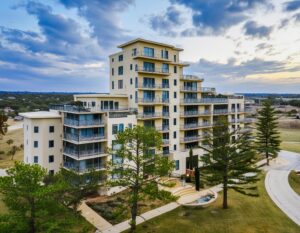- Stabilizing Demand: The Oklahoma City multifamily market is showing signs of stabilization after a softer demand that increased vacancy rates and led to rent growth rates similar to those before the economic downturn.
- Vacancy and Rent Trends: Despite the initial rise in vacancy rates, the expansion of these rates has slowed since the latter half of 2022. Rent growth will likely remain low through the end of the current year, with improvement anticipated starting in mid-2024.
- Past Performance: Before the recent downturn, the multifamily market benefited from strong job growth and limited new housing supply. This helped decrease vacancy rates and allowed for rent increases.
- Construction Activity: Over the past year, construction activity has been moderate, with the development of 1,500 new units suggesting a managed approach to new supply in the market.
- Economic Risks and Diversification: The market faces risks from a slowdown in employment and population growth, particularly with challenges in the energy sector, which heavily influences the local economy. Efforts to diversify the economy into industries like financial technology, aerospace, and biotechnology will likely indirectly support the multifamily market.
Page Contents
- Market Stabilization
- Geographical Demand Trends
- Economic Diversification and Tenant Stability
- Strategic Investment Considerations
- Softening Rent Growth
- Rising Affordability Amidst Economic Shifts
- Investment Implications
- Steady Construction Growth
- Key Development Areas
- Impact of MAPS 3 on Development
- Strategic Development and Investment Opportunities
- Investor Confidence in Oklahoma City Multifamily Assets
- Central Oklahoma City Leading Investment Sales
- Strategic Implications for Future Investments
- Closing Thoughts
Market Stabilization
 Demand in Oklahoma City’s multifamily market is showing signs of improvement. This change comes after 2022, which reported the weakest net absorption in over two decades. Even as vacancy rates have risen, they stay within the typical range seen over the past ten years. The manageable construction pipeline suggests that vacancy rates should remain close to pre-crisis norms in the near term.
Demand in Oklahoma City’s multifamily market is showing signs of improvement. This change comes after 2022, which reported the weakest net absorption in over two decades. Even as vacancy rates have risen, they stay within the typical range seen over the past ten years. The manageable construction pipeline suggests that vacancy rates should remain close to pre-crisis norms in the near term.The improved demand and controlled supply are encouraging signs for investors. These factors indicate a potential for stable rental income and occupancy rates. As market conditions stabilize, strategic real estate private equity partners might find attractive investment opportunities in this sector.
Geographical Demand Trends
Demand varies significantly by location within Oklahoma City. The Northwest, Central, and Canadian County submarkets have led in demand over the past two years. Meanwhile, Downtown Oklahoma City has seen a resurgence in demand, stabilizing vacancy rates in the urban core.
The revitalization efforts through the Metropolitan Area Projects have spurred growth downtown. Investment in infrastructure and enhancing the urban core continue to attract businesses and residents. This ongoing development will likely bolster multifamily demand downtown in the foreseeable future.
Economic Diversification and Tenant Stability
Oklahoma City’s economy is gradually diversifying, reducing reliance on the energy sector. This diversification has helped stabilize the economy by attracting non-energy employers and enriching the tenant base. More people moving to the city has led to a steady decline in unemployment.
Despite this progress, the energy sector’s challenges pose a risk. The industry has experienced significant employment losses, raising concerns about the city’s economic reliance on oil and gas. The durability of growth driven by other sectors remains a critical question for the future of Oklahoma City’s multifamily market.
Strategic Investment Considerations
As the market evolves, strategic partners should consider several factors for investment. Understanding geographical demand shifts and economic diversification is crucial. Real estate private equity firms and capital groups can leverage this insight to tailor their investment strategies, focusing on areas with high growth potential and stability.
Continued focus on multifamily properties in regions like Downtown Oklahoma City seems promising. These areas benefit from urban revitalization and economic diversification, which are likely to drive demand. Such strategic investments can enhance portfolio performance and provide long-term benefits to institutional investors.
Softening Rent Growth
Rent growth in Oklahoma City has softened over the past year due to weaker demand. Rent growth will likely slow further in the near term. By 2024 and beyond, growth rates will likely normalize to about 2% to 3%. Despite this slowdown, rents remain relatively affordable, priced at $950/month, significantly below the national average.
This affordability could make Oklahoma City an appealing market for renters and investors. The lower rent levels compared to the national average present a competitive advantage. This scenario suggests a potential for strategic investments in multifamily properties for real estate private equity firms, anticipating a rebound in rent growth.
Rising Affordability Amidst Economic Shifts
Oklahoma City’s multifamily rents have become increasingly affordable. Despite the economic downturn, particularly with the contraction in high-salaried jobs in the energy sector, household incomes have risen. Since 2015, the median household income has increased by about 15%, reaching over $60,000.
Rental rates for mid-tier and high-end properties have not escalated significantly. Over the same period, rents for 3 Star and luxurious 4 & 5 Star properties have increased by only about 6%. This modest increase in rental costs and rising incomes enhance housing affordability in the city.
Investment Implications
 The current trends offer strategic opportunities for capital groups and investors. Increasing household incomes and controlled rent increases create an attractive market dynamic. This environment is ideal for real estate private equity entities looking to expand their portfolios with investments that promise stable returns and potential for appreciation as the market recovers.
The current trends offer strategic opportunities for capital groups and investors. Increasing household incomes and controlled rent increases create an attractive market dynamic. This environment is ideal for real estate private equity entities looking to expand their portfolios with investments that promise stable returns and potential for appreciation as the market recovers.Investors should closely monitor these economic indicators. Understanding the relationship between income trends and rental rate adjustments will be crucial in making informed investment decisions. Capital groups can leverage this data as strategic partners to position themselves advantageously in the Oklahoma City multifamily market.
Steady Construction Growth
Oklahoma City’s construction pipeline has remained stable, steadily increasing over the past two years. Annual construction starts have ranged between 1,000 to 1,500 units. Construction levels reached 3,700 units, showing modest growth compared to similar markets.
This steady growth suggests a balanced approach to expanding the city’s housing supply. The careful management of new construction helps prevent market oversaturation. For real estate private equity investors, this indicates a well-regulated market with the potential for steady demand.
Key Development Areas
Most new construction concentrates in specific areas: Northwest, Edmond, Downtown, and Canadian County. Canadian County, in particular, has become a popular area for renters, supported by its rising population growth. Upcoming projects like The Silos in downtown Edmond, which will add 280 units in 2024, are part of broader efforts to revitalize these areas.
These developments are poised to enhance local neighborhoods and attract more residents and businesses. The additional retail concepts planned alongside residential units in Edmond will likely increase the area’s attractiveness, thereby boosting demand for multifamily properties.
Impact of MAPS 3 on Development
The latest MAPS initiative, MAPS 3, continues to drive significant development in Oklahoma City. Key projects include Scissortail Park and the new Convention Center, which are drawing more attention from multifamily and retail developers.
The transformation of historical buildings like the First National Center, completed in early 2022, adds unique value. This historic office high-rise underwent conversion to include 193 apartment units, a 146-room hotel, and retail space. Such projects contribute to urban revitalization and will likely attract a diverse tenant base.
Strategic Development and Investment Opportunities
The ongoing developments and strategic urban planning initiatives offer prime opportunities for strategic partners and capital groups. By investing in regions undergoing revitalization and new construction, investors can capitalize on growing demand and the influx of amenities that attract higher-income tenants.
For investors, the key is to align investment strategies with areas showing significant infrastructural and residential development. Understanding these dynamics will help make informed decisions about where to allocate resources to maximize returns in the Oklahoma City real estate market.
Investor Confidence in Oklahoma City Multifamily Assets
Investors are keen on multifamily properties in Oklahoma City, seeing value in smaller tertiary markets. These markets, including Oklahoma City, offer stable demand drivers and a lower entry cost. Over the past year, investors sold 69 multifamily assets, totaling a sales volume of $480 million. However, rising interest rates due to tighter monetary policies aimed at controlling inflation are increasing the cost of borrowing and affecting deal-making speed.
Despite economic fluctuations, investors’ enduring interest highlights Oklahoma City’s appeal. The relatively lower cost and sustained demand in the area make it a strategic choice for firms looking for growth opportunities outside larger urban centers.
Central Oklahoma City Leading Investment Sales
Central Oklahoma City significantly contributed to the city’s investment sales, bringing in over $146 million last year. The largest transactions include the purchase of Sycamore Farms Apartments by Weidner Apartment Homes for $59 million, or $148,200 per unit. Weidner has emerged as one of the most active buyers in the area. In 2021, they also acquired The Edge at Midtown from Cornerstone Development for $55 million, setting a new high for price per unit in Oklahoma City at $220,000.
These high-profile sales underscore the strong investment interest in key areas of Oklahoma City. With its thriving market conditions and low vacancy rates, Central Oklahoma continues to draw significant capital investments.
Strategic Implications for Future Investments
The strong sales activity and significant deals in Central Oklahoma City indicate a robust market for multifamily assets. This region’s ability to attract large investments despite rising borrowing costs speaks to its resilience and potential for sustained growth. Strategic partners and capital groups should consider these dynamics when planning future investments.
Investors can capitalize on stable returns by focusing on areas with high transaction volumes and low vacancy rates. These regions offer promising growth opportunities, making them attractive targets for real estate private equity and strategic partnerships in the multifamily sector.
Closing Thoughts
In conclusion, Oklahoma City’s multifamily market remains a vibrant investment landscape, attracting significant interest from investors priced out of larger markets. The region’s stable demand drivers and strategic growth opportunities underscore its potential for robust returns. Central Oklahoma City, in particular, continues to draw substantial investment, highlighting its appeal. For tailored investment strategies and opportunities, contact Lumicre for your investment needs.